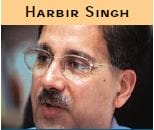Two years ago San Francisco’s Wells Fargo, one of the country’s best-known banks, succeeded in its hostile takeover of First Interstate Bank in Los Angeles. That victory, as it turned out, was Pyrrhic.
Layoffs and branch closings soon sapped employee morale, while customers stayed away in droves after good checks bounced and deposits were lost. The reason why this matters is that in mid-June, Wells Fargo merged again — tying the knot this time with Minneapolis’ Norwest Corp. Though the combined company will form a financial-services giant with 2,900 branches sprawling across 21 states, lots of people are wondering, understandably, whether the merger will work this time or whether it will repeat the failures of Wells Fargo’s earlier acquisition.
Harbir Singh, professor of management, has strong opinions about that — and with good reason. “There was enough noise about Wells Fargo’s First Interstate acquisition to suggest that the consolidation was not working effectively,” he says. Wells Fargo, however, chose to pursue the deal with Norwest. If this merger goes through, it will see the birth of an institution with $181 billion in assets.
Wells Fargo and Norwest are hardly alone. In recent times, many banks have faced the same question: How can they ensure that their mergers will succeed? If this issue seems especially relevant now, it is because the past two months have seen a rash of massive mergers rock the financial services industry. Citicorp and Travelers Group, for instance, will soon come together to form Citigroup, a behemoth with $700 billion in assets. Banks such as First Union, CoreStates, First Chicago, Bank America, NationsBank and Banc One have also declared their urge to merge. And these megadeals are just the most visible signs of a prolonged process of industry consolidation. A decade ago the U.S. banking industry had more than 1,200 commercial banks. Today, notes Singh, there are about half that number.
How, then, can these banks make their mergers work? The answer may lie in a study that Singh recently completed with Maurizio Zollo, a Wharton PhD graduate who is now a professor at INSEAD in France. Titled “The Impact of Knowledge Codification, Experience Trajectories and Integration Strategies on the Performance of Corporate Acquisitions,” the study is the largest so far of post-acquisition management. Based on their findings of more than 500 bank mergers, Singh and Zollo conclude that past experience holds the key to managing a successful merger. Banks that have gained knowledge during past mergers, and turned it into codified procedures and routines, have the best chance of acting decisively after they take over another institution. Risky as mergers always are, organizations that have systematic routines to manage the post-merger scenario have a better crack at success than firms that lack such procedures.
Three factors came together to make this large-scale study possible. First, Singh saw that as the provisions of the Glass-Steagal Act were scaled back, and barriers to inter-state banking fell, the banking industry would see a wave of consolidation. “If you compare the banking industry in the U.S. to other countries that do not have state-level restrictions, you find that the industry is dominated by a few, very large banks,” he says. This meant that the banking industry would offer enormous opportunities for a major study of post-merger management. Secondly, Zollo was keenly interested in writing a thesis on this topic — which helped solve the manpower problem. Finally, the Wharton Financial Institutions Center, which has access to funds from the Sloan Foundation, agreed to financially support the research.
Singh and Zollo did their research in two phases. They started out by doing field surveys, interviewing some 45 executives in nine banks that had been actively snapping up other institutions. They followed this up by sending out questionnaires to 250 of the country’s largest bank holding companies. In all, Singh and Zollo studied more than 50 banks and 577 acquisitions.
Their research showed that a significant shift had occurred in the way banks managed their mergers. Before 1990, when one bank took over another, it generally managed it as an independent affiliate, rarely making changes in its systems or even management team. As the banking industry began to consolidate, however, its standards of efficiency became increasingly more exacting. As a result, in mergers that occurred after 1990, acquiring banks were under growing pressure to integrate the working of the acquired bank with their own. This let them reap economies of scale and squeeze other efficiencies out of combined operations. Says Singh: “A bank that doesn’t integrate may find it easier to manage the institution it has taken over, but it may be unable to make its transaction viable.”
The knowledge that allows banking industry executives to carry out such integration, Singh and Zollo discovered, is broadly of two types. The first, which they term tacit knowledge, consists of subjective experience and is largely in the heads of key executives. The second variety, which they call codified knowledge, consists of written procedures that a bank articulates in the form of routines, which can be swiftly put in place after a merger.
For example, procedures might spell out what the layout of a bank’s branches would look like after an acquisition. Or, if one bank with 25 products has merged with another that has 30, norms might suggest how the two will be integrated. Still other policies might govern the bank’s commercial lending policies or human resource issues such as hiring, training, outsourcing and even downsizing after the takeover. Banks that develop systematic procedures about such issues, over time, become better at managing their mergers. In contrast, the absence of such procedures, especially in a volatile, emotion-charged, post-merger environment, can wreak havoc — besides depleting the value of the merged company.
Codified procedures in particular are not just crucial; they are indispensable, Singh says. “If you need to do a lot of integration, you need to have procedures in place, even if you end up having to impose one firm’s policies upon the other.” Having codified procedures allows banks to accomplish a crucial task: It lets them reckon how much cash flow various activities will generate and factor them into financial projections.
But what if two banks are in relatively different businesses? Consider, for instance, Wells Fargo and Norwest. While Wells Fargo sells itself as “an urban bank for people on the go,” and operates with minimal staff and a large network of ATMs, Norwest is a massive mortgage lender that depends on a large staff to nurture customer relationships. Would experience gained in managing acquisitions in one type of bank be relevant in a merger with the other? Singh says that banks constantly face such challenges. “You have to decide how much of your knowledge applies to the current transaction, and how much is a useless legacy from the past.”
Though Singh and Zollo focus on banking in their research, Singh says that their findings also apply to mergers in other industries. For example, take the impending union of Daimler Benz and Chrysler, which has caused an upheaval in the auto industry. Though this transaction is often touted as a marriage of equals, Daimler Benz is clearly the acquirer, Singh notes. Still, both companies face huge challenges, some of which revolve around issues of executive compensation. “Chrysler’s CEO earns much more than Daimler’s, and if that is true of the CEOs, you can assume that the salary differential goes several levels down,” he adds. “How will that be handled? It’s an interesting challenge.”
Singh sees similar challenges in the mega-deals going on in telecommunications. A case in point: WorldCom’s takeover of MCI, a transaction that some wags suggest is like MTV buying Masterpiece Theater. “When WorldCom bought MCI, it took over a company that was three times its size in terms of employees,” says Singh. “How can you ensure that such a merger is going to work?”
The positive side of this deal, he adds, is that Bernard Ebbers, WorldCom’s chief executive officer, had bought some 40 companies before taking over MCI. In the process, WorldCom became very good at combining assets. “Before the merger, WorldCom had a strong Internet backbone, and after the merger it has the best Internet backbone in the U.S. and Europe,” Singh says. “But on the negative side, taking over MCI is different than any of WorldCom’s past acquisitions.”
Challenging as it is to decide what tacit and codified knowledge is relevant in such transactions, the problem becomes much more complex when mergers cross industry frontiers. For example, when American Home Products recently announced its intention to merge with Monsanto, it spelled the combination of a pharmaceutical giant with an agricultural and biotechnology company. Wall Street’s response to the declaration has been underwhelming; the stocks of both companies barely moved after the merger was announced in early June.
Could Singh’s and Zollo’s findings apply to such a deal? “I would argue that tacit knowledge would not apply,” he replies. “Codified knowledge also would not seem relevant. For such a transaction to work, based on our study, it would have to be based on an under-valuation of assets.” Singh adds that when two companies are in different industries, the value created by integrating their operations would be minimal. The way to make such mergers work might be to keep their operations relatively independent.
In addition to tacit and codified knowledge, corporate culture plays a seminal role in making or breaking mergers. The challenge, claims Singh, is not that companies that merge tend to be culturally distant; it is how they address that cultural distance. This implies that even if two companies are in the same industry, are located in the same region, and draw upon the same labor pool, they would still be culturally distant.
Singh’s research into factors that make mergers work has had several spinoff possibilities for other studies. One project, which he is working on with Prashant Kale, another PhD student, concerns how companies gain knowledge as well as protect proprietary information in joint ventures. Singh also plans to extend the study to mergers in the insurance industry, as well as deals between banks and non-banks.
Meanwhile, he says, the rising tide of bank mergers will not abate anytime soon. “This will go on for a while,” he says. “Banks that are unable to combine operations successfully will be on the block again. If you are not good at managing your merger, someone else is going to buy you — and create value.”
























